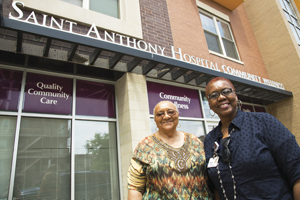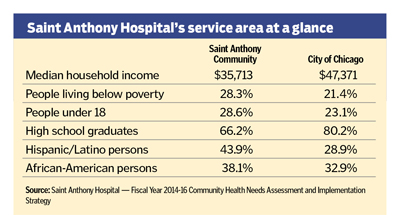By BETSY TAYLOR
CHICAGO — Saint Anthony Hospital in southwest Chicago wants to be known as a "hospital without walls," reaching out to community leaders and area residents to build relationships and provide more access points for health care and for wellness education.
In the past two years, the stand-alone hospital has deepened its local roots, opening a community wellness center in North Lawndale and an outpatient clinic in Little Village — low-income neighborhoods that bookend the hospital and are its primary catchment area. The clinics improve access to primary and specialty care for patients and encourage people to receive care before they require costly emergency treatment.

Annie Crump, 78, left, and Diane Rice, manager of health care navigation at Saint Anthony Hospital in Chicago, stand outside of the Saint Anthony Hospital community wellness center in the city's North Lawndale neighborhood. Crump sits on the hospital's senior advisory council.
Saint Anthony has a bold plan in the works for a replacement hospital to open by 2018 about 2 miles away from its current location. The hospital will be an anchor tenant at Focal Point, a 22-acre mixed-use community campus at 31st Street and Kedzie Avenue in the Little Village neighborhood. The redevelopment project will combine inpatient and outpatient services with retail, arts and recreation facilities. The Chicago Southwest Development Corp. bought the first 11 acres for Focal Point from the city of Chicago for $1 last year. Focal Point's architects won a national health care design award for "master planning urban design" from the American Institute of Architects in 2013. The AIA jury said the project represents a trend for health and community integration in urban environments.
Guy A. Medaglia, Saint Anthony's president and chief executive, heads the redevelopment corporation as its president and chief executive. Focal Point will bring in jobs and services that residents asked for in a series of in-depth interviews and surveys, and revitalize the area, hospital leadership said.
As hospital staffers explain it, the proposed Focal Point development, currently in its design phase, could become a spot where patients can get a haircut or grab lunch while waiting for their MRI results. Under the redevelopment plan, rental income from revenue-generating tenants, like stores, restaurants, schools, day care, a parking garage and Saint Anthony would be reinvested into not-for-profit programs and services provided through the campus, such as wellness classes, a creativity center and recreation.
The total project cost of about $500 million will be financed by grants, philanthropy and other sources, according to information given out about the project. The redevelopment authority will be applying for tax credits. Focal Point is an ambitious undertaking. Medaglia has said the innovative model will "reinvent community development."
"You work with people, and people will work with you," Medaglia said.
 Steadying the ship
Steadying the ship
In Chicago, the nation's third largest city, residents have dozens of hospitals from which to choose, and Saint Anthony did not always fare well against the competition. In 2007, Saint Anthony was losing roughly $12.5 million a year, and on the verge of closing, according to published accounts. Medaglia first came to Saint Anthony as a managing director at FTI Consulting in 2007 when the hospital was part of a large health system. In 2009, Saint Anthony's board decided the hospital should separate and operate independently, and in 2010, it offered Medaglia the position as president and chief executive.
The hospital renegotiated contracts to improve insurance reimbursement and to win concessions on prices for goods and services. More accounts personnel were added to ensure the hospital accurately was collecting for its services. According to Saint Anthony's 2012 annual report, the most recent report available, it ended 2009, 2010, 2011 and 2012 with positive balances. Justin Bynum, Saint Anthony chief financial officer and vice president, said the net income from hospital operations was $299,000 for fiscal year 2013.
Staffers also turned their focus outward to assess community health needs and better understand the neighborhoods the hospital serves.
Saint Anthony straddles two communities, with its front entrance opening to the predominantly African-American North Lawndale neighborhood and its back bordering the predominantly Latino Little Village. It long was known for serving the Hispanic population, hospital staff said, and over the past seven years it has increased efforts to draw patients from other populations, particularly African-Americans living in North Lawndale. Today, Saint Anthony says more than
70 percent of its patients come from six densely populated zip codes on Chicago's west and southwest sides. Its service area includes the North and South Lawndale, Little Village, Pilsen, Back of the Yards, Bridgeport and Austin neighborhoods. The hospital says it also has patients from the near west suburbs of Cicero and Berwyn.
Saint Anthony has remained open, in part, because the outreach efforts changed its payer mix, Medaglia said. While less than 1 percent of the hospital's patients have commercial insurance, and net patient service revenues have declined somewhat in recent years, expanding where the hospital draws its patients from increased the percentage of patients with Medicare, which reimburses for services at a higher rate than Medicaid. (Medicaid hospital tax assessment revenue is a significant income source for Saint Anthony.)
Collaboration is essential
In September of 2012, Saint Anthony opened a community wellness center at a location where Martin Luther King Jr. lived in 1966 when working for housing equality in Chicago. Rows of windows that let in natural light and a street-level entrance make it a welcoming spot. Neighbors stop in. They can learn about upcoming educational programs, have a free pregnancy test, find out about available mental health services or fill out an application for area food pantry eligibility.
Still, staffers say they don't always have as many resources as necessary to meet demand. That's where collaborations with other organizations are key. Tameeka Christian, Saint Anthony director of community wellness and government relations, said, "If someone walks through our doors, if we don't provide the service, we should have a relationship with someone who does and can help them."
Small world
That's in evidence at a neighborhood café in North Lawndale, run by an organization that often teams up with Saint Anthony to improve area residents' health. North Lawndale is home to about 36,000 residents and lacks many of the jobs and conveniences residents here would like. It's a food desert. To address the neighborhood's lack of sit-down restaurants and access to fresh, healthy food, another organization working in the neighborhood, Lawndale Christian Health Center, opened the Green Tomato Café. The menu includes healthy choices named for area neighborhoods and streets, like a
Little Village "ensalada" and an Ogden egg sandwich with vegetables. On a recent visit, an elderly woman carried a Saint Anthony bag as she ordered a green smoothie. During an ensuing conversation, the senior told the Saint Anthony employees in line behind her how much she enjoys her meetings with Diane Rice, Saint Anthony's manager of health care navigation, who coordinates senior wellness efforts and helps patients coordinate care.
As part of the effort to collaborate as it moves care beyond the hospital walls, SAH Community Care Clinic, affiliated with Saint Anthony, opened the new outpatient clinic in Little Village less than a year ago. A $5 million renovation allowed for specialty services on site, including a nonprofit dialysis center, immediate care (which is what urgent care is called in Illinois), occupational therapy, radiology and ultrasound services. Saint Anthony partnered with Esperanza Health Centers to provide family practice and Sonrisa Family Dental for oral health care. The clinic is less than a mile from the hospital.
Rita Esquiliano, Saint Anthony director of community relations, said that by locating the clinic in a shopping plaza, the hospital let people know it was willing to bring services to them. For residents without vehicles, having health care even a little closer to home can make a difference, and they may visit the clinic earlier before an illness escalates and they need emergency care.
The hospital reaches into the community in other ways too, holding an annual Summer Fest in its parking lot, where children can have a back-to-school physical and adults can be screened for health conditions. Christian said at the fair, people in need are linked to care providers and phone calls are made to follow up and remind patients of appointments.
Medaglia said the hospital listened when community leaders made it clear: "For you to help us with our needs, you need to be out with us."